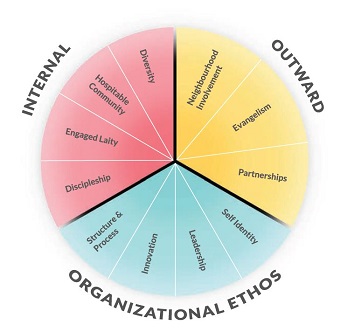
Joel Thiessen will lead a one-day seminar on flourishing churches at Columbia Bible College May 4.
Sociologist Joel Thiessen will address the question, “Is there hope for congregations today?” – based on Canada-wide research – during a day-long Flourishing Congregations: From Understanding to Practice seminar at Columbia Bible College in Abbotsford May 4.
Following is an article in which he introduces some of the relevant issues.
What is a flourishing congregation? This is a question that our research team at the Flourishing Congregations Institute is grappling with.
The answer? As we discovered during our interviews and focus groups with over 100 Canadian church and denominational leaders across Protestant and Catholic sectors . . . it depends.
The answer is contingent, in part, on theological tradition. Distinct denominations stress various elements of Christianity, and thus define the markers of a flourishing congregation differently.
For example, Baptists might accentuate evangelism while those in the United Church of Canada might stress diversity. Region also matters. If you live in a rural region with declining populations due to ageing, low birth rates and migration away to other provinces, you likely think about congregational life differently than those in an urban centre.
Congregations and denominations interact with their theologies and social contexts in diverse and complicated ways, which leads us to conclude that a single answer to the question at hand is neither an accurate nor helpful way to proceed.
Of course, we do have some clues from our research to date, which include data from an ongoing national congregations survey. I will focus on three key insights. The first is that most (perhaps all) congregations are flourishing in some ways. Moreover, few (if any) congregations are flourishing in every way. When you think of your own congregation:
• Where do you see signs of life and vitality?
• What are the strengths of your church?
• What draws you and others to return to your church week after week?
Build on strengths
 Asking these questions of your leaders and congregants could be an excellent way to take the pulse of those in your congregation. The answer might be the hospitable community that you encounter with one another. It could be your leaders. Perhaps it is the meaningful discipleship that takes place, which could include excellent preaching, or music, or programs. Maybe it is the impact that your congregation has in the surrounding neighbourhood.
Asking these questions of your leaders and congregants could be an excellent way to take the pulse of those in your congregation. The answer might be the hospitable community that you encounter with one another. It could be your leaders. Perhaps it is the meaningful discipleship that takes place, which could include excellent preaching, or music, or programs. Maybe it is the impact that your congregation has in the surrounding neighbourhood.
Regardless of how you answer, our team has concluded that congregations have some areas where they see greater signs of flourishing than others, and that congregations should celebrate, accentuate and build upon these strengths.
Numerical growth
Second, there is a great debate about whether flourishing entails numerical growth. Can a congregation that remains the same size, or possibly declines in size, be considered a flourishing congregation?
Many in our study believe there is a link between flourishing and numerical growth in attendance, membership, financial giving, baptisms, conversions and so forth. From our survey data thus far, those who say their congregations are growing are most likely to also believe their congregations are flourishing.
At the same time, we heard many times that congregations can flourish without growing numerically. For example, from our survey, 20 percent of those in declining congregations say their churches are flourishing. Here people tend to stress transformed lives – “even if our congregation is not growing, people’s lives are being changed and for us that is an important hallmark of flourishing.”
The discussion about numbers is a complex one. In one sense, if you don’t have numbers, you don’t have a viable and sustainable organization. Without bums in seats, and money in the offering plate, and volunteers to assist with the many good things that take place in a congregation, it is difficult for a congregation to thrive. As many Canadian congregations have experienced, the absence of human and financial resources means that churches close.
Still, there are countless examples of congregations that have massive budgets and thousands of people who attend each week, yet confront significant challenges of leadership scandals, hostile relationships among members and neighbourhoods which experience no tangible benefits from these congregations.
To complicate things further, the source of church growth might be interpreted differently, depending on your theological perspective. For instance, our survey data indicate that very few churches are growing due to new converts; growth occurs mainly because of transfer growth, either from one church to another, or from those who move from one city to another. Is this a sign of flourishing? The answer likely depends on who is answering and in what social context.
Core domains
 Third, several traits rose to the surface when we asked leaders and congregants to identify what they thought constitutes a flourishing congregation. We have analyzed that data to build our Flourishing Congregations Construct (available on our website).
Third, several traits rose to the surface when we asked leaders and congregants to identify what they thought constitutes a flourishing congregation. We have analyzed that data to build our Flourishing Congregations Construct (available on our website).
We focus on three core domains with several dimensions (see graph).
Organizational Ethos
Beginning with Organizational Ethos, congregations benefit when they are clear on their identity, have leaders who develop and equip other leaders, experiment and try new initiatives, and have organizational structures and processes that help them accomplish the things they believe they are called to do and be in their specific context.
Internal
Internally, flourishing congregations prioritize robust and intentional discipleship practices, laity who are engaged in various facets of congregational life, hospitable communities where people are loved and cared for, and the involvement of people from diverse demographic backgrounds.
Outward
The Outward dimension involves congregations whose neighbourhoods would notice if they were no longer there, who emphasize and practice evangelism, and who partner with other organizations to strengthen their collective capacities to accomplish shared goals.
Again, congregations from different theological traditions place more emphasis on some of these traits over others. Which of these variables would you identify are integral to a flourishing congregation, and why? Where would you say your congregation is or is not flourishing in each of these dimensions?
Final thoughts
So, what is a flourishing congregation? Perhaps you hoped to read about three things that you should do to help your church grow. Such an article might be interesting; however, there are many resources available already that try to deal with that task. I hope that this article helps clarify why the question of flourishing congregations is not as straightforward as most assume – and in the process, offers an accurate and honest engagement with what our team is hearing on the ground in congregations across Canada.
If you are interested in learning more about the research at the Flourishing Congregations Institute, or you wish to include your congregation in our national survey, visit us at www.flourishingcongregations.
Dr. Joel Thiessen is a professor of sociology and director of the Flourishing Congregations Institute at Ambrose University. Check out his website at: www.joelthiessen.ca and follow him on Twitter: @joelthiessen.
This comment is re-posted by permission.
